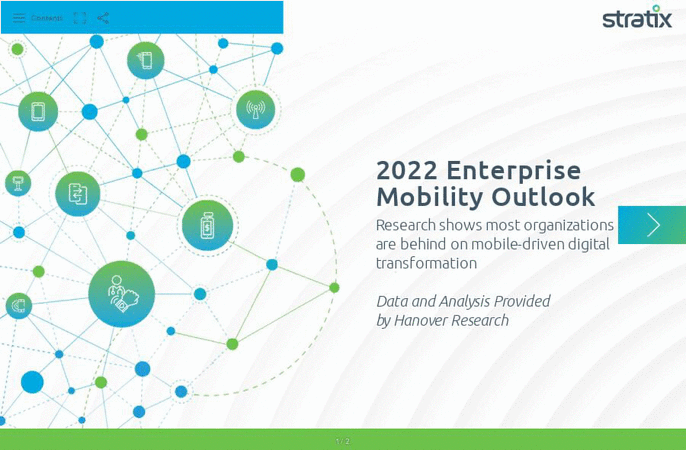2022 Enterprise Mobility Outlook Shows Most are Behind on Mobile-First Digital Transformation
Written by Elizabeth Klingseisen
Blog
Part of Stratix’s role as an enterprise mobility leader is studying our industry to understand what organizations need, what’s holding them back, and what strategies are driving success. Every year, we put out our Enterprise Mobility Outlook, which is a report card on current trends across different industries. With our research this year, we wanted to understand where companies are after two years of pandemic disruption, reveal their pain points, and see where they’re headed.
Last year’s research showed how the pandemic dramatically accelerated mobile-driven digital transformation—with innovators and early adopters doing better at weathering the disruption. In addition to nimbleness, many organizations saw how mobile solutions bring more benefits like higher productivity and better user experiences. All those positives have organizations adopting mobile-first principles that put mobile at the heart of strategy, operations, and the user experience. That’s going to accelerate with 5G, which is creating new mobility use cases thanks to faster speeds, lower latency, and the ability to connect more Internet of Things devices. In a recent report, IDC predicts that “more than 70 percent of global enterprises and 60 percent of U.S. enterprises plan to move to a wireless-first strategy for local and wide-area operations in the next two years.”
So, with the Enterprise Mobility Outlook 2022, we wanted to see where enterprise organizations are on their mobile-first journey and look at what’s working and what’s not. We partnered with Hanover Research to poll a broad range of IT and organization leaders across industries.
Perception Very Different from Reality
New for 2022, we’ve created a Mobile-First Score that ranks organizations on their mobile-driven digital transformation and asks them to rate themselves. We found a big gap between our score and self-perceptions. The majority (53%) describe themselves as mobile-first, but only 29 percent score high on our battery of key indicators.
The research shows that while many organizations are using mobile, it’s not as widespread as it could be. Decision-making is decentralized, with few using a holistic strategy to gain strategic advantages and cost savings.
BYOD Losing Favor?
This year, we looked at device ownership within enterprises and use case strategies. Eighty-six percent of organizations provide corporate-owned mobile devices to employees, with just 14 percent relying on Bring Your Own Device (BYOD). BYOD raises security concerns, and employees often prefer not to give employers high levels of control over their devices, citing privacy worries.
While the majority of enterprises provide devices, they are often shared, and most organizations are rethinking their shared device strategies. They point to significant management issues—such as getting the devices back to the charging cradle, check-in/check-out processes, battery life, and more.
Significant Customization Required
Off-the-shelf mobile technology is not an option for the majority of the respondents in our study. Two-thirds say they need customized devices. Nearly half rely on the Android operating system—which is known to be more customizable and offers a broader range of device types—including rugged.
However, iOS is only 12 percentage points behind. It’s popular in industries like retail and healthcare, where less customization is required, and end users are already familiar with Apple devices because they use them in their private lives.
Challenging Times for IT Teams
Nearly all organizations report at least some degree of difficulty finding qualified IT staff, and very few have internal device repair capabilities.
Leaders told us that their teams spend significant amounts of time each week on mobile technology management. Thirty percent said security is a constant concern, and 20 percent spend all week on end-user support—with the majority devoting three or more hours a week to it.
Almost all enterprises have a partnership with a Mobile Managed Services Provider (MMSP). Nearly half outsource support, while 40 percent use MMSPs for deployments and telecom expense management. Far fewer manage in-house or rely on OEMs.
Different Pictures for Different Industries
The 2022 Enterprise Mobility Outlook found significant contrasts between different industries in their self-perception, mobile-first score, and challenges.
Retail organizations, for example, are far less likely to describe themselves as mobile-first. While they’ve adopted many mobile solutions for things like inventory or curbside pickup, their strategies haven’t reached a more holistic level. Field service organizations did much better on our Mobile-First Score assessment than manufacturing, retail, and transportation.
Field Services were also the most likely to rely on an MMSP followed by manufacturing, transportation, and retail. Retailers were more likely than other industries to utilize shared devices but also reported high levels of challenges with that strategy and were looking to make changes.
Read the Report
There’s a lot more information on how enterprises are leveraging mobile-first strategies to get ahead in our full 2022 Enterprise Mobility Outlook. Read it today to learn more about our new Mobile-First Score and how your industry stacks up.

2022 ENTERPRISE MOBILITY OUTLOOK
Research shows most organizations are behind on mobile-driven digital transformation.
Read Report













